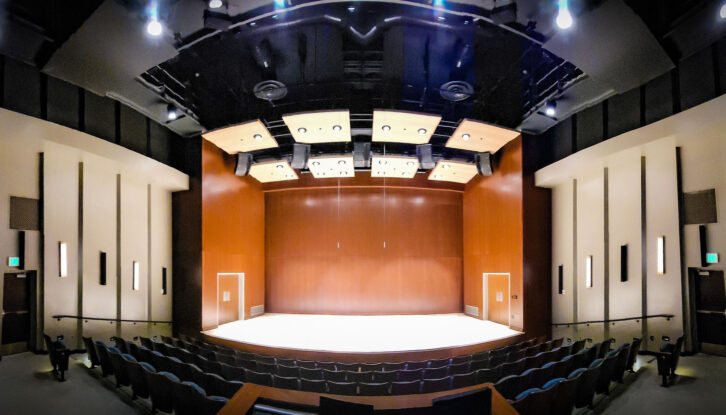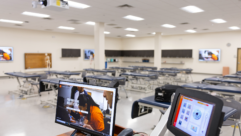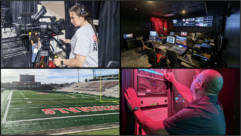
Construction of Brigham Young University’s new School of Music Building took two years to complete, and it was worth the wait. The 170,000-square-foot center was built to house BYU School of Music’s performance and academic spaces and relieve some of the burden on the university’s Harris Fine Arts Center, which hosted over 500 performances a year before its demolition this past March, paving the way for a new Arts Building to be completed on the same site in 2025.
The new Music Building has four levels and features several mid-sized spaces for rehearsals and recitals, including practice rooms on the upper floor. The cornerstone of the facility is a 1,000-seat Concert Hall built in the vineyard style in which the performance space takes center stage, with tiers of audience seating rising above them.
The cutting-edge buildout included two L-Acoustics L-ISA immersive sound systems: one in the Recital Hall performance space and the other in a teaching space, The Box, both installed by Salt Lake City-based Poll Sound Integration, who also installed an L-Acoustics Kiva II system into the building’s new Concert Hall. The ability to move between teaching and performance spaces and remain in a fully immersive environment sets a new benchmark for immersive audio in education.
Both the Recital Hall and The Box are fitted with L-ISA immersive audio technology. The Box was initially envisioned as an opera rehearsal room, but including L-ISA has allowed it to become a much more versatile performance space, now used for classes, rehearsals, and immersive audio composition groups. Kevin Anthony, assistant professor in the composition department and an electronic music composer, says the decision to outfit both spaces with immersive audio emerged from discussions amongst the AV team and faculty members who saw that L-ISA technology could greatly increase the flexibility of those spaces.
“It was exactly what we need for much of the electronic music that our students produce,” he says. “And we also want to be able to host electronic music conferences here, so having L-ISA immersive sound was precisely what we required.” Asked if immersive audio had made inroads into academic settings yet, as it has in cinema and other sectors, Anthony replied that this was the first such installation he’d seen. “It’s a dream setup to have,” he says.
 That “dream setup” in the Recital Hall consists of five A10i Focus and ten A10i Wide loudspeakers plus six KS21 subs, eight coaxial X8, and 15 ultra-shallow Soka colinear enclosures, collectively driven by a combination of LA12X and LA4X amplified controllers and an L-ISA Processor. In The Box, the immersive speaker array comprises five Syva colinear loudspeakers, two KS21 subs, and 21 X8, all controlled by an L-ISA Processor and powered by LA4X amplified controllers. Equally nice is the new Concert Hall’s sound system, with its 24 flown Kiva II speakers buttressed by five A10i Focus, five A10i Wide, and six SB15m subs, all driven by LA12X amps and a P1 processor. In addition, four rehearsal rooms each utilize two self-powered 108P and a pair of SB15P subs; a dozen classrooms all feature two 108P; and a portable PA system comprising a combination of X8, X12, and KS21, powered via LA12X and LA4X, is ready for deployment as needed.
That “dream setup” in the Recital Hall consists of five A10i Focus and ten A10i Wide loudspeakers plus six KS21 subs, eight coaxial X8, and 15 ultra-shallow Soka colinear enclosures, collectively driven by a combination of LA12X and LA4X amplified controllers and an L-ISA Processor. In The Box, the immersive speaker array comprises five Syva colinear loudspeakers, two KS21 subs, and 21 X8, all controlled by an L-ISA Processor and powered by LA4X amplified controllers. Equally nice is the new Concert Hall’s sound system, with its 24 flown Kiva II speakers buttressed by five A10i Focus, five A10i Wide, and six SB15m subs, all driven by LA12X amps and a P1 processor. In addition, four rehearsal rooms each utilize two self-powered 108P and a pair of SB15P subs; a dozen classrooms all feature two 108P; and a portable PA system comprising a combination of X8, X12, and KS21, powered via LA12X and LA4X, is ready for deployment as needed.
BYU Director of Audio Visual Services Brad Streeter, who designed all of the new facility’s sound systems in concert with L-Acoustics technicians and Poll Sound AV System Designer/Project Engineers Neil Yates and Bryce Stettler, and PM Dan Salmond, noted that research around immersive sound for the new facility extended beyond the new music facility.
“We were doing AV design work for two buildings concurrently: the Music Building, which was begun and completed first, and a new Arts Building currently under construction. We were also researching immersive systems for the Arts Building, experiencing different manufacturers’ demos at trade shows,” he explains. “We all felt the L-Acoustics L-ISA technology was the best fit for the proscenium theater in the new Arts Building, and the research showed it was also relevant to the spaces in the Music Building.”
Reaction to the new immersive audio capabilities in the facility has been highly positive. Anthony says they’ve been used for applications ranging from teaching to composition to performance, all while introducing students to the concept of immersive audio. “One of our grad students, Jinxin Fu, is composing a piece specifically to be performed using L-ISA, and several other music students are taking advantage of its real-time spatialization capabilities in an upcoming concert,” he says. “Composition faculty member Steve Ricks just staged a large-scale opera performance in The Box where I designed a ‘weather’ system with sounds of trees and other natural effects that were spatialized throughout the space. It was cool to see that space and the sound system used to its full measure.”
BYU is far from finished with L-Acoustics technology. Bryce Stettler, in charge of commercial sales at Poll Sound, noted that the company is gearing up to install a new K2 system in the Marriott Center, the multipurpose arena on the university’s Provo campus that is home to BYU Cougars men’s and women’s basketball teams. With seating for nearly 18,000 people, it is the largest venue in the entire Big 12 Conference and among the largest oncampus basketball arenas in the nation.
In the meantime, BYU’s music faculty is still finding new ways to apply the L-ISA immersive technology to their work. They anticipate making it part of the learning and performance experience in the new facility. “I think as far as these systems are concerned, they’re new to us and a new technology for campus,” says Anthony. “We’re looking forward to doing a lot of experimentation and seeing where it’ll be most useful, and that’s tremendously exciting.”










